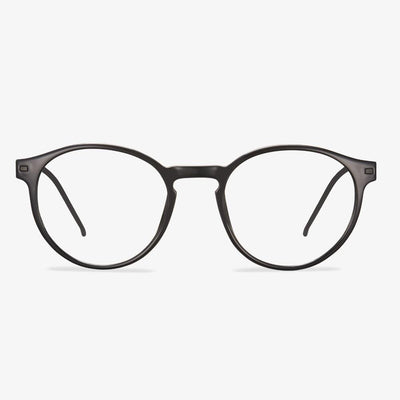How to test a blue-light lens?
Look at the lens. High-quality anti-blue glasses do not interfere with the line of sight, with high transmittance. The light transmittance is very high, and the visual clarity is higher, which does not affect the visual quality, quality of life, contrast sensitivity, and color discrimination.
What Glasses Are Made Of?
In general, most glasses are made of plastic lenses. Why are glasses lenses made of plastic? In fact, plastic glasses are lighter than traditional glasses lenses used in eyeglasses, which means they are more comfortable to wear. At the same time, it is easy to apply lens coatings like anti-reflective to plastic lenses.
Besides, children’s glasses are also made of plastic because it is more resistant to impact. There are four main types of plastics used to make eyeglasses and sunglasses lenses which are plastic, Trivex, polycarbonate and high-index plastics.
The plastic lenses made from CR-39 were first introduced. CR-39 is an abbreviation for Columbia Resin #39, the 39th plastic of that type made by Columbia Resin.
Then the polycarbonate glasses were invented. Polycarbonate became out of this world once it found use in aeronautics. Polycarbonate is a type of plastic that can be produced as transparent and easily shaped, making it great for glasses lenses. Polycarbonate is impact resistant so that they are a good lens choice for kids. And the polycarbonate lenses have 100% UV protection.
Next, high-index lenses are available. High-index lenses have a high refractive index with a thin lens. Although high-index lenses are thinner, they are heavier due to the higher density of these plastics.
So, what glasses are made of? Most glasses are made of plastics. Then how are glasses made? To get the answer, keep on your reading.
Editor's Pick: Polarspex Polarized Night Driving Glasses
The most popular product on Amazon is Polarspex's line of polarized sunglasses. A wide variety of finishes are available. You'll want to select Night Driving Yellow lenses for your night driving glasses. Affordable and stylish, these glasses feature a plastic frame, metal-reinforced hinges, and plastic polarized lenses designed to block BOTH UVA and UVB rays.
The Advantages of Polycarbonate Glasses
In fact, polycarbonate glasses come with several benefits and this section will show some of them.
First, polycarbonate glasses are safe and are virtually unbreakable. A study found that polycarbonate glasses were more impact-resistance than glasses or other types of plastic lenses.
Second, polycarbonate glasses are thinner than other types of lenses. This feature makes them ideal for people who have strong prescriptions. Lighter and thinner eyeglasses are less likely to slip off your nose and are more comfortable for everyday wear.
Third, extended exposure to UV radiation from the sun can cause damage to your eyes and lead to some eye conditions such as cataracts or macular degeneration. Of course, polycarbonate glasses can block out harmful UV rays from the sun and provide good protection for your eyes.
However, there are some negative voices of polycarbonate lenses.
Why can't you wear expired contact lenses?
Contact lenses have a throwaway cycle. If the contact lens has been opened, the shelf life of the contact lens is calculated from the day it was opened. Contact lenses have a life cycle. The life cycle is the shelf life of contact lenses. For example, if you wear daily contact lenses, you will have to throw them away. If you wear monthly contact lenses, they will have a shelf life of one month. Even if you wear them only a few times, you will still have to throw them away. The shelf life of contact lenses is calculated from the day the lenses are taken apart, not from the number of days they have been worn.
After the shelf life of contact lenses, there will be some cases like lens aging, hardening, lens discoloration, decreased transparency, lens deformation, thickening, an increase of lens protein, and other precipitates. The microbe is easy to deposit, resulting in poor oxygen permeability. If you continue to wear it, it is easy to cause inflammation of the conjunctiva and corneal hypoxia, and the comfort level will be much worse. It is suggested to analyze the case according to your own care. Once the contact lenses have the above cases, they should be replaced in time.
Proof Eyewear
The origins of Proof Eyewear date back to 1954. The company went global from garage to sustainable eyewear in just a few years. They provide products handmade from sustainable materials, including sustainably sourced wood, biodegradable cotton-based acetate, and recycled aluminum. The acetic acid Rx series features an environmentally friendly frame and hand-layered cotton-based acetate fiber. It is a completely renewable, biodegradable, hypoallergenic alternative to petroleum-based plastics. Some styles come with sustainable wood or metal detailing, and most come with clear or blue-light lenses. Wood harvesting is one of the best sustainable sources of handmade wood. The hand-layered structure creates durability with a unique environmentally friendly design. All frames come with stainless steel spring hinges and a hand-polished waterproof/perspiration resistant natural plant-based sealant.
The disadvantages of progressive lenses
- The field of view in the near and middle distances is relatively narrow.
- The adaptation time is longer and patients with greater astigmatism are not suitable for wearing.
- The peripheral aberration is large, and there will be large astigmatism in the periphery.


















































